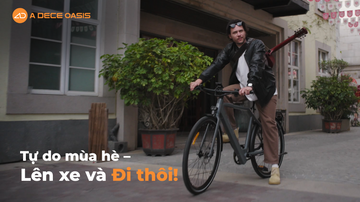
Product reference:
- Working principle of bicycle brake
The general working principle of bicycle brakes is that when the brake is pressed, the force of the squeeze acts on the brake pads. Creates friction between the brake pads and the wheel. Thereby reducing the speed of the vehicle.
2. Instructions on how to use bicycle brakes properly and safely.
2.1. Brake according to the rules for each type of vehicle:
- For the brake line of terrain-assisted bicycles, street cars, and folding power-assisted bicycles: When braking, you should use a combination of both front and rear brakes.
- Particularly for racing bikes: Because the rider moves at high speed, the rear brake should be used, then the front brake should be used. This way helps the driver not to roll forward because of sudden braking.
2.2. Squeeze the bike with your index finger:
When moving, especially on rough and dangerous roads. At this time, it requires you to steady the steering wheel to keep balance. Use your index finger to squeeze the bike, making your handlebars firmer and more stable. At the same time flexibly handle emergency situations faster.
2.3. Lower yourself and keep your handbrake on the turn:
Lowering yourself and keeping the bike's handbrake on the turn is a technique you need to pay attention to. This helps you keep your balance better and safer. As you approach the bend, gradually lower your hand to the downward bend at the handlebars. This, both helps you lower your center of gravity, and makes it easier and safer to use the bike brake.
After the bend, regain the most comfortable sitting position and keep the car at your desired travel speed.
2.4. Push your body weight back after braking:
Braking causes the main force to be concentrated and the front wheels up to 70% of the body weight. Therefore, speed control or parking is difficult to do at this time. Therefore, after braking, push your body weight backwards to regain balance for you and the bike.
3. Some notes when using bicycle brakes:
3.1. Bicycle brakes on wet roads:
Using bicycle brakes in rainy, wet road conditions is quite difficult. As it reduces the deceleration efficiency due to reduced friction. Therefore, brake earlier with a softer squeeze. Let the vehicle slow down slowly.
3.2. In case of emergency braking:
The emergency brake is often used when you are moving and you suddenly notice an obstacle ahead. Therefore, when braking sharply in this case, you should lower your body and put your force behind, to stop the car safely.
3.3. Avoid skidding:
For many people, when braking, bicycles often slip, leading to loss of balance and falls. To limit this situation, it is necessary to remember the braking technique for each type of vehicle in each case. Especially, you should regularly check the condition of the tires and replace them when the tires are too worn.
Above is some information of ADO E-bike to guide you how to brake your bike properly and safely. Wish you successful application and have meaningful trips with your favorite power-assisted bike.
The ADO E-Bike is a solid companion in urban living. We create products that provide a great driving experience on complex traffic conditions such as bumpy, rocky and uphill. All ADO products are designed to be environmentally friendly and comply with environmental guidelines.





